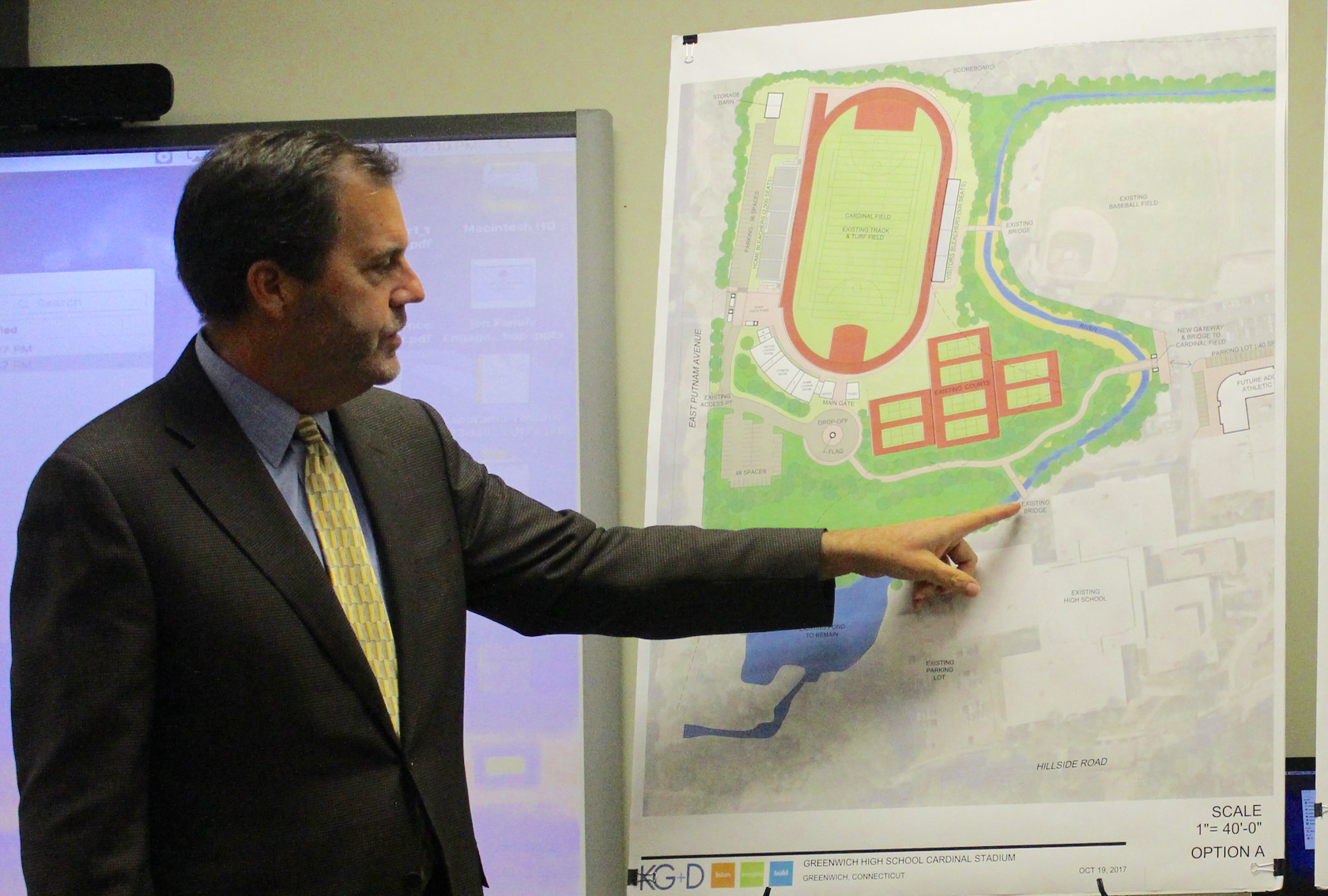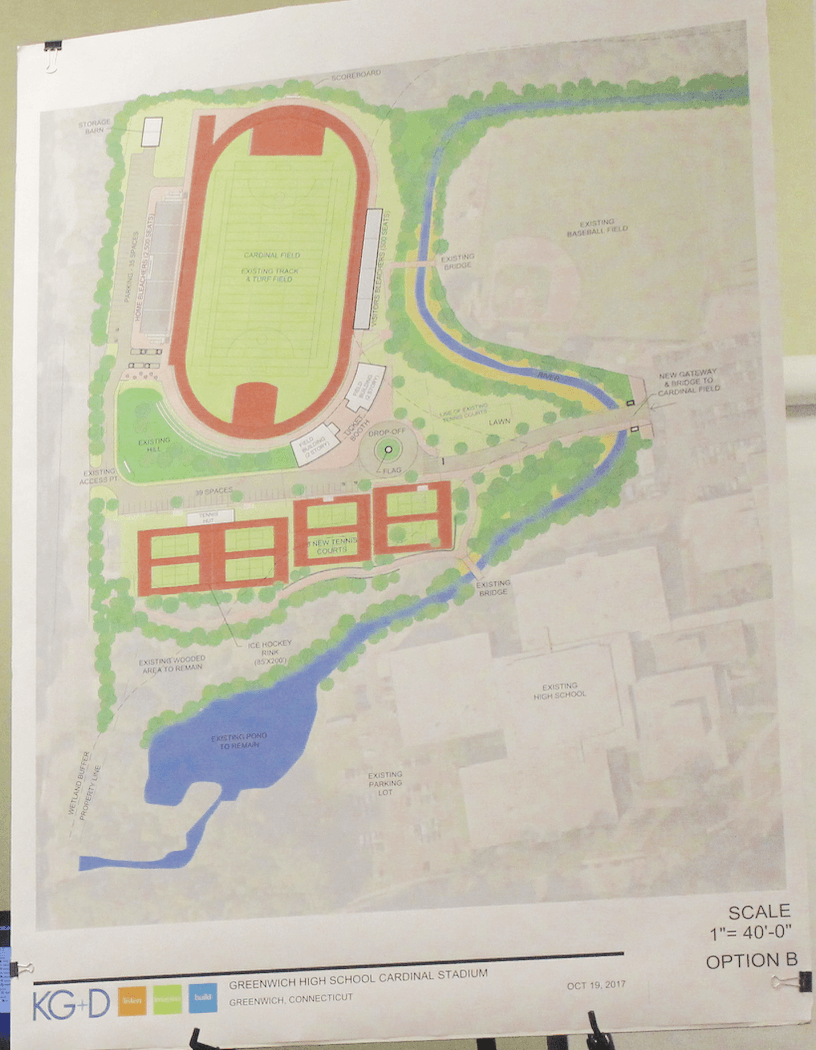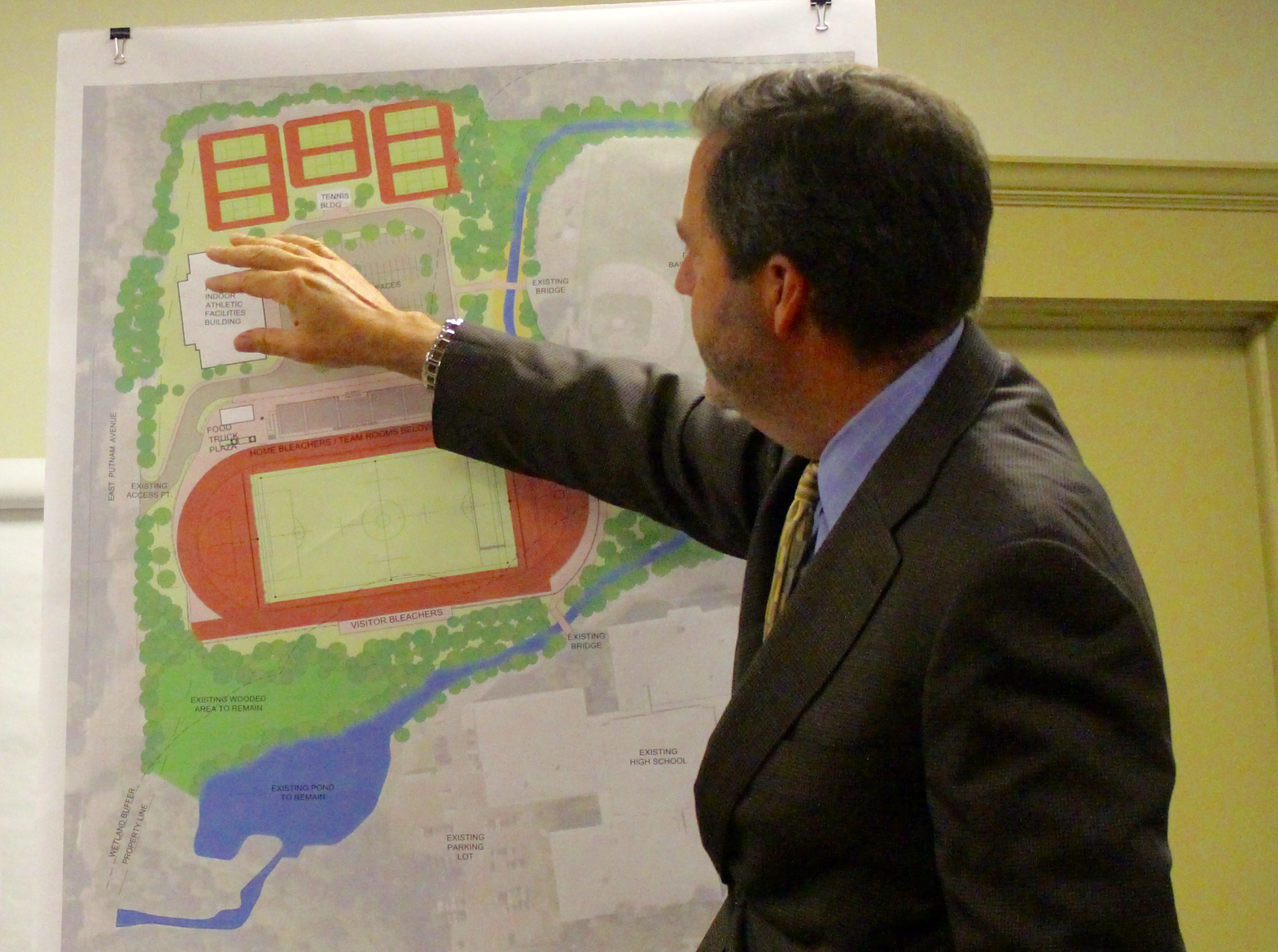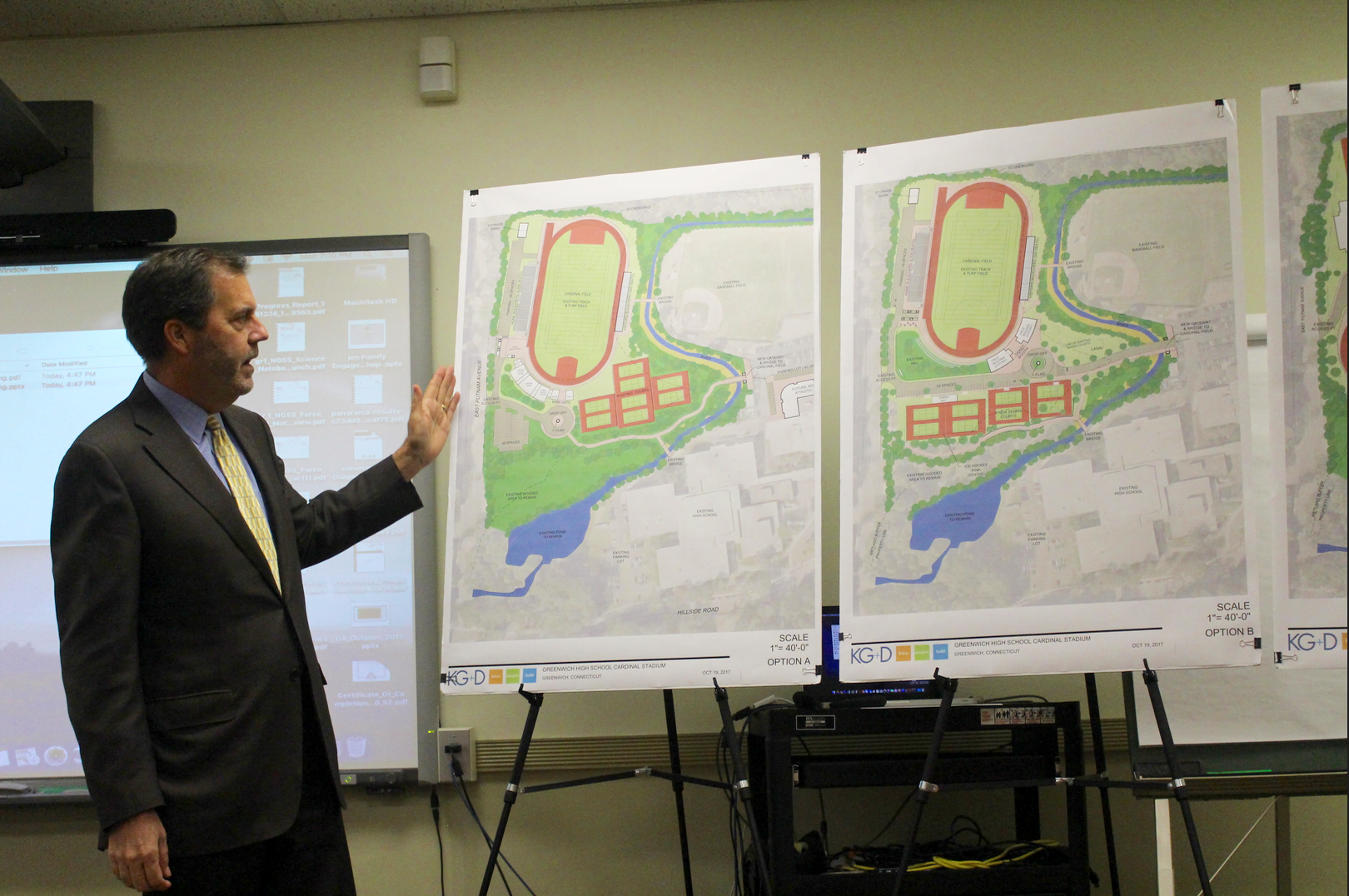On Monday night Greenwich Schools superintendent Dr. Jill Gildea hosted a session at Havemeyer for neighbors of Greenwich High School.
About 20 neighbors attended the presentation on upgrades to Cardinal stadium, field lighting, traffic and other issues in the context of later bell times at the 2,591 student Greenwich High School and an overall Facilities Master Plan across Greenwich Schools.
GHS now starts at 8:30am, and dismisses at 3:30pm, which has had negative consequences for athletes.
In a variety of sports, student-athletes are missing more class time to get to away games, and feeling the pinch of less daylight for practices and home games.
Last week, on the first day of daylight savings the JV football team competed on field 7, which was pitch dark before the game ended.
On Monday night, about a dozen neighbors were told to hold questions until the end of the presentation, which focused on three options for lighting and reconfigurations of items including the tennis courts and Cardinal Stadium, placement of changing rooms and bathrooms, and potential vehicle access from Putnam Ave.
Neighbors nevertheless interrupted the presentation with questions about whether the meeting was properly noticed, soil remediation and ulterior motives.
One Old Church Road neighbor, Diana Delano, repeatedly called the new superintendent disingenuous.
Earlier in the day on Monday, Old Church Road neighbor Bill Effros had penned a stern email to the superintendent saying according to the terms of the 2003 Court Ordered Judgment and Stipulation, the district was required to notice of all Municipal Improvements involving the GHS campus via certified mail no less than 30 days ahead of time.
He also said the meeting violated the 2003 court ordered judgement, because the “presentation” was actually to preview a $30,000,000 Municipal Improvement Site Plan, which he said violated municipal code because the MI had yet to go before P&Z and RTM.
Dr. Gildea, who was accompanied by Chief Operating Officer Lori O’Donnell and Facilities Director Daniel Watson, who are also both new to their jobs, said repeatedly that the meeting was strictly informational, to connect with and get feedback from neighbors.
“Nobody is wanting to make quality of life worse,” Gildea told the neighbors. “This is conceptually only. …We want your input.”
Gildea put the presentation in context, saying GHS anticipates a modest increase in enrollment, and adjustments to the building would be needed. Monday’s presentation, she said, reflected a what-if scenario.
“What if, we’re asked to do it, what we would do?” she said, adding that looking at Cardinal field was part of the facilities master plan, which is under way.
“It’s not to do with neglect, it just needs to be updated,” she said, adding that school security has evolved quickly, analog data must be converted to digital, and enrollment is expected to increase.
In the context of the overall facilities review, she said, “We were asked to do a feasibility study for upgrading Cardinal stadium.”
The experts assembled included Russ Davidson, FAIA, president at Kaeyer, Garment & Davidson Architects; Robert Banning, P.E. of Silver Petrucelli and Associates and Ryan Chmielewski, a landscape architect at Milone & MacBroom Inc.
Mr. Chmielewski said his firm had worked with multiple towns in Connecticut, including Darien, which recently lit a field. He said his firm was brought on to study the existing infrastructure at Cardinal Field and evaluate the effects of shifting the school day forward by an hour.
His firm inventoried practice schedules and games, and quantified the deficiencies.
For starters, Cardinal Field (field 1), which is only allowed by court order to have 10 games and 6 practices illuminated during the entire year, is certainly deficient.
“And, there is no lighting allowed, period, on the fields,” he said, adding, “Real estate is very hard to come by to develop several acres to develop.”
Before going on to recommend various lighting options Chmielewski said, “I’m not an attorney, I can’t answer a legal question.”
Ultimately, Chmielewski said his recommendation is to light fields 6 and 7, noting that field 7 has no impacted soils, and that field 6 is only partially contaminated.
Using those two adjacent fields would allow for combined trenching. And there are already two poles there.
There was no mention of a temporary sports bubble or bubbles, which would not count toward FAR, which currently is maxed out at GHS.
In fact, for the MISA, a variance from ZBA was granted. A temporary sports bubble, used even one day less than 6 months out of the year, doesn’t count toward FAR and would be opaque so neighbors don’t see the lights.
Robert Banning said the LED lights on fields 6 and 7 could be powered without temporary generators because the existing electrical conduit comes close to the field.
Further, he said, “Modern LED sports lights have hundreds of individual lights that are individually aimed on each fixture.”
“We can aim them more vertically directed,” Banning said, adding that there is less ‘sky glow,’ less glare for players and less ‘light trespass’ off the property lines.
Dr. Gaetane Francis, a BOE member who fielded questions from the neighbors said she had visited the Greenwich Skating Club at the end of Hillside Road, where the poles are lower than proposed at GHS, but the lighting technology is similar to what is proposed. “It’s quite impressive. There’s no glare,” she said.
Mr. Chmielewski was not even through his presentation when neighbors peppered him with questions.
“This is well and good,” said Hillside Road neighbor Ashley Cole. “More games means more traffic, more noise and more disruption.”
Asked whether the district would be considering the changes at GHS if not for the new bell times, Dr. Gildea said the upgrades are necessary anyway.
“We’re exceeding the capacity of the current infrastructure,” Gildea said. “You need to consider this as a town either way.”
Elizabeth Dempsey of Hillside Road said GHS was a terrible neighbor. “You are totally forbidden to do this,” she said, adding, “I don’t know anyone in Hillside or Brookridge Associations who are in favor. And I oppose it. There are so many permit violations, besides the legal factor. That’s affronting.”
“You can’t steam roll environmental, property and zoning issues,”she said.
The superintendent said the town is indeed working with the EPA.
“We’re monitoring ground water and doing everything we have to do,” she said.
Dr. Gildea explained that the Dept of Public Works is coordinating work with the EPA. “That’s why we met with DPW,” she said. “That’s why in options A and B, the fields stay put and don’t disturb new areas.”
“This is not a meeting going around P&Z or leapfrogging anybody. This is informational, as part of a 15 year study,” Gildea said.
Neighbors described the blasting to create field 7 in 2005 as a nightmare and that no notice was given to neighbors, who now have cracked foundations.
“The town has come in and done things that are damaging,” Ms. Dempsey said.
“We’re trying to meet with you early about what is being fathomed,” board member Dr. Gaetane Francis replied, adding there is a false rumor circulating about buying neighbors’ properties.
Ms. Cole suggested replacing Central Middle School with a sports complex and stadium, with appropriate parking.
“I’m pro public schools, but we have 3,000 kids crammed into a tiny, inappropriate spot filled with toxins,” she said. “It’s time to do the right thing, which is to clean up the fields.”
“We’re trying to turn a sow’s ear into a silk purse,” she said. “CMS school is at the end of its life span. It’s really kind of a dump. There’s 22 acres, not that many neighbors, and GHS kids can walk there.”
“We have two elementary schools that are under enrolled – Parkway and North Street. We could move CMS to one of those schools and combine those two,” she said.
“There’s no redistricting involved, we alleviate the pressure off the high school, and we give the kids more fields, more space, less density and traffic, and once we do that, we can then remediate the fields, clean it up,” Cole said.
“Because leaving this stuff in our environment is the wrong thing to do for the kids. It’s time that Greenwich and the town clean this mess up and get it right. There is really no other choice here. It’s the right thing to do.” – Ashley Cole, 11 Hillside Rd
After Dr. Gildea tried to assure neighbors that environmental regulations would be followed, but Diana Delano of Old Church Rd was having none of it.
“We think you are bullies,” Delano said. “You are thoughtless. You try to steamroll the neighbors. We’re sick of it. It’s been going on 2o years.”
“You can spend millions and we can spend millions fighting you, or we can take the next step and do something better for our kids and the environment,” Ms. Cole said.
When Ms. Dempsey described GHS as a terrible neighbor, GHS headmaster said, “Nobody is pretending we’ve been perfect neighbors, but boy have we been trying.”
He said that after MISA, extra money was spent on LED lighting to lower glare, and that $35,000-40,000 of electrical work was done to decrease light from science wing. Also, he said, “When the music was a problem at practices, we spoke and we turned it off.”
RTM member from District 3 in Chickahominy, Dawn Fortunato asked about executive sessions.
“This is not pending litigation. You’re thinking about re-opening it (litigation). How long have executive sessions been going on?” she asked. “How long has this been an issue being discussed?”
“We have had 6 executive sessions related to legal strategy,” replied Laura Erickson.
“The sessions were to inform the board what the stipulation covered and didn’t,” said outgoing BOE member, Debbie Appelbaum.
Laura Erickson, whose term is also set to end shortly, said that the two new board members, Kathleen Stowe and Meghan Olsson were both invited to one executive session.
Mrs. Delano had the last word. “The history of dealing with the town has been one of continued contempt. You do not honor covenants you agree to. You are not trustworthy. We are sick of it. We have had it. None of us believe we can deal in good faith with the high school and the town.”
Option A, Option B, and Option C
Russ Davidson, FAIA, president at Kaeyer, Garment & Davidson Architects outlined the deficiencies of Cardinal Stadium, and then outlined Options A, B and C.
“There is no handicapped access and handicapped parking is too far away,” Davidson said of Cardinal field. ” Also, there is a lack of toilet facilities, and the bleachers are failing. They have temporary supports under them and were manufactured in around 1970.”
Davidson said the main bleachers need to be replaced. However, he said, “We need a plan to reconfigure the field before replacing any one element of it.”
For background, Davidson said the team of experts had shown all the town departments the three options, had a preliminary discussion with Wetlands, and reviewed permitting issues.
“All the department heads believe, with the right approach, all those hurdles could be overcome,” he said.

Option A
Option A. Bleachers would be moved forward. Add parking behind the bleachers. Track and field remain in place. Add handicap ramp. Remove the first rows of bleachers because the first 3-4 rows are “not very useful.” Big feature: a second pedestrian bridge and gateway. Construct a buildings for team rooms, first aid, training facility, place for referees to change, and public toilets, and bleachers that are handicapped accessible. And a new access point and a drop off loop.

Option B
Option B Moves tennis courts, which are currently in a wetlands buffer. Add a gated road that, “with certain conditions,” would go from the GHS parking lot straight through to Putnam Ave.
Features a drop off loop. Includes building with team room and bathrooms. The big change is moving the tennis courts out and adding the gated road.
“We are well aware that there a lot of permitting issues,” Davidson said, adding that road would be valuable for emergencies, and would allow cars to exit the parking lot by a different way.

Option C
OPTION C is Davidson described Option C as “a more radical departure,” noting, “There are issues with soil in this area, so option C has more potential issues with soil contamination. More testing would have to be done.”
Field and track are moved down and rotated 90° to decrease afternoon sun glare.
“When sun goes low, one team is always looking at the sun,” he said, adding, “We don’t know why it was originally put east-west.”
Includes an 8-lane track. Relocate the tennis courts to the west end of the site. Main pedestrian access comes in with a covered walkway. Includes an opportunity for a future indoor athletic facility, either a gymnasium or field house. Davidson described Option C as “a pretty costly proposal” that would take at least a year.

Russ Davidson, FAIA, president at Kaeyer, Garment & Davidson Architects
The Board of Education scheduled a public hearing Tuesday evening to discuss “options with regard to lighting the athletic fields at Greenwich High School.” The special meeting/hearing is scheduled for 6:15 p.m. at Central Middle School’s gymnasium.
See also:
Greenwich Board of Ed Votes 5-3 in Favor of Implementing School Start Change for Fall 2017
GHS Cardinal Stadium Lighting Upgrades and Deed Restrictions Leave Greenwich Hamstrung. Again.

Email news tips to Greenwich Free Press editor [email protected]
Like us on Facebook
Twitter @GWCHFreePress
Subscribe to the daily Greenwich Free Press newsletter